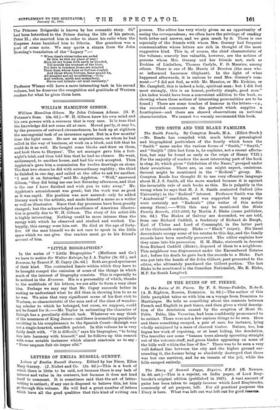WILLIAM HAMILTON GIBSON.
William Hamiltor. Gibson. By John Coleman Adams. (G. P. Putnam's Sons. 10s. 6d.)—W. H. Gibson knew his own mind and his own powers with a sureness that is very rare. It is true that the knowledge did not come all at once. Moved partly, it may be, by the pressure of outward circumstances, he took up at eighteen the uncongenial task of an insurance agent. But in a few months' time the light came. He saw an acquaintance, on whom he had called in the way of business, at work on a block, and felt that he could do it as well. He bought some blocks and drew on them, and took them to Harpers'. The art manager gave him a fort- night's trial, and then told him that he had no chance. He went, undismayed, to another house, and had his work accepted. Then Appleton's gave him a commission for twelve drawings on stone. The first two stones he did with extraerdinary rapidity ; the third he finished in one day, and called at the office to ask for another. "I sent it on Saturday," said Mr. Appleton. "Well," answered Gibson, "they did bring me one last Saturday afternoon, and that is the one I have finished and wish you to take away." Mr. Appleton's astonishment was great; but the work was as good as it was rapid. His position was now assured: only he added literary work to the artistic, and made himself a name as a writer as well as illustrator. Since that day processes have been greatly changed; but the acknowledged excellence of American illustra- tion is greatly due to W. H. Gibson. The story of his artist-life is highly interesting. Nothing could be more intense than the energy with which he observed and studied and worked. Un- happily, this energy wore him out. He died at the age of forty- five. Of the man himself we do not care to speak in the little space which we can give. Our readers must go to his friend's account of him.






















































 Previous page
Previous page